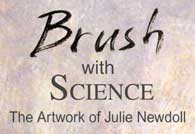

Life Forms: Basic Structures of Our Existence; Origin of Ourselves.2003 marks the 50th anniversary of discovering the structure of DNA. These paintings are a reflection upon the basic structures that make our existence possible, and an exploration into how they came about.
 View Portfolio |
 Inside Time |
 Shows |
 About/Contact the Artist |
“Dawn of the Double Helix”, oil and mixed media on canvas, 18” x 25”, 2003. Private Collection (sold)
Print $450
From the “Life Forms” series, an in progress group of paintings exploring our basic structures and origins.
Inspired in part by the book "Rosalind Franklin; The Dark Lady of DNA" by Brenda Maddox, Harper Collins Publishers, 2002.
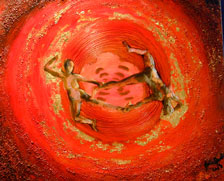 Base Pair, 18" x 24", oil and mixed media on canvas, 2003. Private Collection (sold). Prints available.
Base Pair, 18" x 24", oil and mixed media on canvas, 2003. Private Collection (sold). Prints available.The dance and the tension between residues, people, male and female. Rosalind Franklin's famous X-ray diffraction photograph of DNA commands the center of the image.
The spiraling couple, frozen for an instant, is exposed to us, revealing the tension between the bases, between male and female, between the scientists involved in the discovery of the structure of DNA. The delicate hydrogen bonds between bases is the premise for a dance that can never stop as long as life continues.
Inspired in part by the book "Rosalind Franklin; The Dark Lady of DNA" by Brenda Maddox, Harper Collins Publishers, 2002.
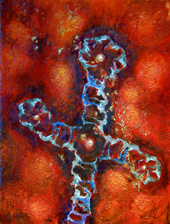 RNA as the New Dogma, oil and mixed media on canvas, 24" x 33", 2003, $2,600 framed.
RNA as the New Dogma, oil and mixed media on canvas, 24" x 33", 2003, $2,600 framed.
Prints available. Purchase Info.Human figures are assembled here into a possible RNA shape. DNA is often thought of as our primary life giving molecule. We may have evolved from RNA in a form that was capable of self replication. Scientists are still discovering more that RNA is responsible for in our cells. Although the bases that make up RNA are very similar to DNA, they can create structures very different from the double helix that we know DNA to typically, but not always, form.
RNA does much more than previously thought, according to John Mattick of the University of Queensland. His research and that of his collaborators may overturn the Central Dogma, the current thinking on how we control and express our genes, in which RNA plays mainly a messenger role. RNA may do much, much more. This is a topic for a new painting series to come.
The figures here are more ancient and ambiguous than those in "Dawn of the Double Helix". Surrounded by forces without and within, these figures collect around pearl-like ions, and brush against metallic flakes of gold. Surfaces such as iron pyrite (fool's gold) may have served as substrates for the first self replicating molecules to form upon.
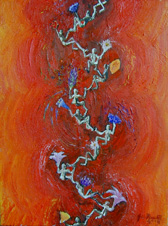 Rise of the Alpha Helix,
Rise of the Alpha Helix,
oil and mixed media on canvas, 18" x 24", 2003.
Private Collection (sold). Prints available.Human figures arranged in an alpha helical arrangement, such as are found in the structure of proteins. The flowers reflect the various types of sidechains that each amino acid holds out to the world.
Inspired by the alpha helix structure found in proteins, discovered by Linus Pauling and Robert Corey, and Herman Branson.
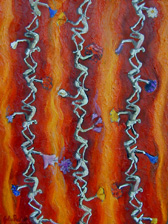 Figures in a Beta Sheet,
Figures in a Beta Sheet,
oil and mixed media on canvas, 18" x 24", 2003. Private Collection (sold).
Prints available.Human figures arranged in a beta sheet, a structure found in folded proteins. The flowers are like the sidechains each amino acid holds out.
Inspired by the beta sheet structure found in proteins, discovered by Linus Pauling and Robert Corey, and Herman Branson.
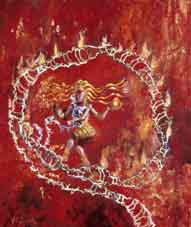 Shiva as Telomerase inside of a Telomere Loop, oil and mixed media on canvas, 2003, 32" x 38", Private Collection (sold). Prints available.
Shiva as Telomerase inside of a Telomere Loop, oil and mixed media on canvas, 2003, 32" x 38", Private Collection (sold). Prints available.Shiva is the dancing manifestation of the Hindu god Nataraja. The dance of Shiva represents a delicate balance of creation and destruction, preservation and evolution, a life force as well as death. Here Shiva is dancing inside of a telomere loop, acting as the enzyme telomerase. The telomere is like the shoelace cap on the ends of a chromosome, keeping the lace (chromosome) from unraveling. Each time a human cell divides, all the chromosomes must also divide. The telomere gets shorter when the cell divides, and the protein “telomerase” inside the telomere binding complex lengthens the telomere again. Telomerase also stabilizes the telomere. The telomere has now been shown to be a large loop called a telomere loop next to a smaller loop, the D-loop.
Telomerase was once thought to be a potential key to the fountain of youth. If it were introduced into older people that no longer make telomerase in their cells, would their cells go on dividing? Cancer cells, on the other hand, have plenty of telomerase to perpetuate their eternally dividing cells. This is still a point of controversy, but it is certain that telomerase is an important enzyme, and one that is being studied carefully.
Inspired in part by the paper "Mammalian telomeres end in a large duplex loop." Griffith JD, Comeau L, Rosenfield S, Stansel RM, Bianchi A, Moss H, de Lange T. , Cell 1999 May 14;97(4):503-14. Information on Shiva from "Nataraja in Art, Thought and Literature" by C. Sivaramamurti, Thomas. Published in Nature Reviews Genetics 4, 845 (2003).
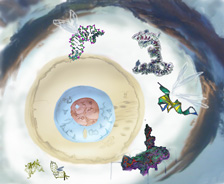 The Evolution of
The Evolution of
RNA World as Insects in the Navajo Creation Story, 24" x 33",
Turned into new painting series, "Emergence".This is a digital sketch of the painting. Watch this space to see the final painting as it develops.
RNA images courtesy of Alice Boit, created using AMIRA graphics from the Konrad-Zuse-Zentrum für Informationstechnik Berlin (ZIB).